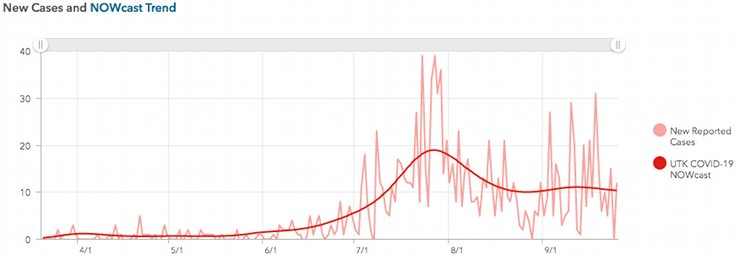
After falling in August, the average number of new daily cases of COVID-19 appears to have plateaued in Anderson County.
But there is at least one complication in the data. More than 30 cases reported in Anderson County in mid-September had been assigned to a different county earlier, or the the county of residence had not yet been reported, according to the Tennessee Department of Health.
So, for at least a few days, the data seemed to include an unusually high number of new cases per day (20-29 new cases per day on September 10 and 11, compared to one to six new cases per day other days that week).
Since then, though, the average number of new cases per day has remained about the same, in a range between 11.1 and 13.7 new cases per day. Fourteen new cases were reported Saturday.
The seven-day average number of new cases in Anderson County had fallen to 5.4 per day on September 1, according to calculations by Oak Ridge Today. That was a low that the county hadn’t had since early July, before new case growth peaked later that month.
But since then it’s gone back up to an average of more than 10 new cases per day, where it appears to have plateaued. It’s not clear why.
Anderson County has reported five deaths due to COVID-19 this month. That’s more than one-third of the 13 deaths reported in the county since the pandemic began March 20. Two of the deaths were reported by state health officials in the past few days, on Thursday and Friday.
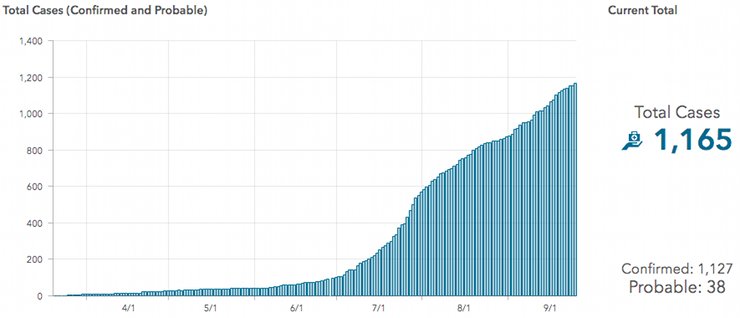
Anderson County has had 1,179 COVID-19 cases, according to the Tennessee Department of Health on Saturday. There have been 13 deaths and 38 hospitalizations. The state reported 114 active cases and 1,052 inactive cases in Anderson County on Saturday.
The number of active cases dropped significantly early this month, from close to 200 to less than 100, when the Tennessee Department of Health changed its reporting format for inactive/recovered. The state once had an automatic 21-day cutoff as one way of reporting that a patient had recovered. But the state can now report a case as inactive when a patient is 14 days or more past the start of their illness or, in cases where they are asymptomatic, the date when they submitted a specimen for testing.
The change was made to “more closely align with what is now known about the infectious period of COVID-19, and to ensure this metric is as accurate as possible because stakeholders are using the number of ‘active’ cases to make decisions about the disease burden in their communities,” the Tennessee Department of Health said. Most patients with COVID-19 are no longer infectious after 10 days, although they may have symptoms for longer that that, the health department said.
The number of active cases in Anderson County peaked, under the old format, at 289 on Sunday, August 2. Active cases are total cases minus inactive cases and deaths.
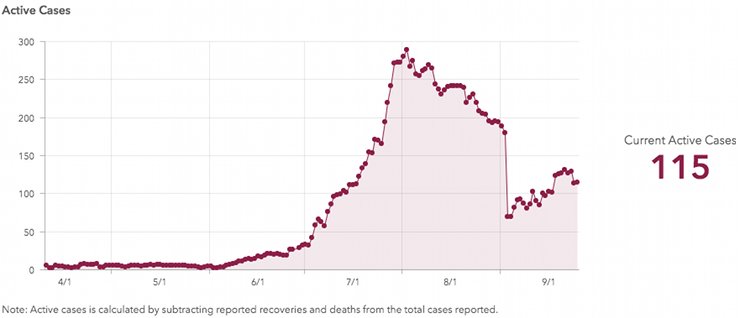
The highest average number of new cases per day in Anderson County, as tracked by Oak Ridge Today, was in the week ending Tuesday, July 28, when there were about 24.7 new cases per day. July appears to have been the worst month of the pandemic in the county so far.
On Friday, the Coronavirus-19 Outbreak Response Experts (CORE-19) at the University of Tennessee in Knoxville reported that the COVID-19 transmission rate in Anderson County was below one, at 0.95. When the transmission rate is below one, the disease is becoming less prevalent.
The percentage of new cases, compared to new tests, has remained at about 5 percent.
There have been 26,241 COVID-19 tests in Anderson County.
COVID-19 daily snapshot
Here are the COVID-19 statistics for Anderson County on Saturday, September 26:
- Total cases—1,179
- New cases—14
- Active cases—114
- Inactive cases—1,052
- Deaths—13
- Total hospitalizations (current hospitalizations could be different)—38
- Total tests—26,241
- Daily rate of new cases to new tests—6.2 percent
- Hospitalization rate—3.2 percent (down about 1 percent from mid-August)
- Death rate—1.1 percent (up about 0.3 percent since mid-August)
- Transmission rate (on Friday)—0.95
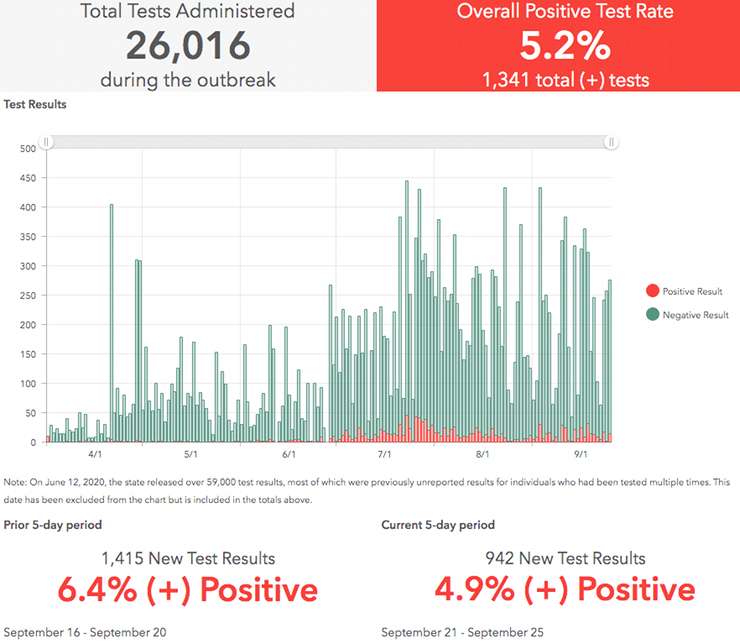
Seven-day case and daily positivity rate averages
Here are the recent seven-day averages of new daily COVID-19 cases in Anderson County calculated by Oak Ridge Today:
- Week ending June 30—3.43 new cases per day
- Week ending July 7—5.86
- Week ending July 14—10.86
- Week ending July 21—15.4
- Week ending July 28—24.7
- Week ending August 4—18.6
- Week ending August 11—9.7
- Week ending August 18—11.4
- Week ending August 25—9
- Week ending September 1—5.4
- Week ending September 8—11.1
- Week ending September 15—12.14
- Week ending September 22—13.7
Here are recent seven-day averages of daily rates of new cases compared to new tests:
- Week ending July 9—5.45 percent
- Week ending July 16—9.37
- Week ending July 23—9.6
- Week ending July 30—8.7
- Week ending August 6—5.5
- Week ending August 13—4.8
- Week ending August 20—5.7
- Week ending August 27—3.6
- Five-day average ending September 1—5.6
- Week ending September 8—5.63
- Week ending September 15—5.01
- Week ending September 22—6.77
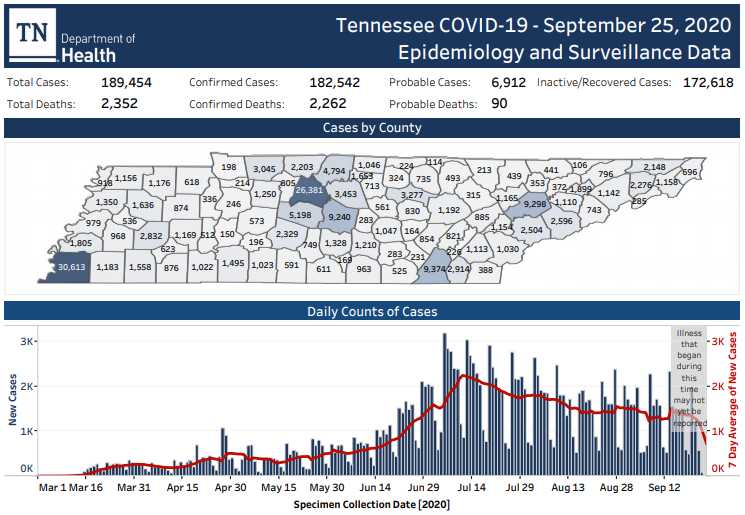
State, county statistics
Here are the COVID-19 statistics for Tennessee on Sunday, as reported by the Tennessee Department of Health:
- Total cases—190,891
- New cases—1,437
- Active cases—15,481
- Deaths—2,374
- Death rate—1.2 percent
- Current hospitalizations—739
- Daily positivity rate—6.34 percent
- Average patient age—39
The first case of COVID-19 was diagnosed in Tennessee on Wednesday, March 4. Since then, there have been more than 2.7 million COVID-19 tests in Tennessee.
The highest number of cases in the state is in Shelby County, which includes Memphis in West Tennessee. The case count there was 30,613 on Saturday. There have been 455 deaths in Shelby County.
In Davidson County, 26,381 cases have been reported. In that county, 303 deaths have been reported. Davidson County includes Nashville in Middle Tennessee.
Other counties with case counts of more than 2,000 on Saturday included:
- Hamilton (Chattanooga area), with 9,374 cases, up more than 2,500 cases since mid-August, and 94 deaths, an increase of 35 deaths since mid-August;
- Knox (Knoxville area), with 9,298 cases, an increase of more than 4,000 cases since mid-August, and 75 deaths, up 33 deaths since mid-August;
- Rutherford (Nashville area), with 9,240 cases and 89 deaths;
- Williamson (Nashville area), with 5,198 cases and 36 deaths;
- Sumner (Nashville area), with 4,794 cases and 97 deaths;
- Wilson (Nashville area), with 3,453 cases and 44 deaths;
- Putnam (Cookeville area), with 3,277 cases and 40 deaths;
- Montgomery (Clarksville area), with 3,045 cases and 44 deaths;
- Bradley (Cleveland area, near Chattanooga), with 2,914 cases and 17 deaths;
- Madison (Jackson area, between Nashville and Memphis), with 2,832 cases and 46 deaths;
- Sevier (Gatlinburg, Pigeon Forge, Sevierville), with 2,596 cases and 15 deaths;
- Blount (Maryville area), with 2,504 cases, up more than 1,000 cases since mid-August, and 24 deaths;
- Maury (Columbia area, south-southwest of Nashville), with 2,329 cases and 23 deaths;
- Washington (Johnson City area), with 2,276 cases and 35 deaths;
- Robertson (east of Clarksville), with 2,203 cases and 35 deaths; and
- Sullivan (Kingsport-Bristol area), with 2,148 cases and 33 deaths.
Here is COVID-19 case information about other counties besides Knox County that surround Anderson County:
- Loudon County has reported 1,154 cases and six deaths.
- Roane County has reported 885 cases with four deaths.
- Campbell County has reported 439 cases and four deaths.
- Union County has reported 353 cases with one death.
- Morgan County has reported 315 cases with three deaths.
- Scott County has reported 213 cases with two deaths.
COVID-19 is a new, contagious illness that can have respiratory symptoms and affect other parts of the body, and it can be deadly. It can cause a range of health issues that can last weeks or months, including fevers, body aches, fatigue, coughing, and breathing problems, among other reported symptoms. The long-term effects remain unknown.
It can be spread by respiratory droplets from coughing, sneezing, talking, and singing. There is also debate about whether it might be spread by airborne transmission.
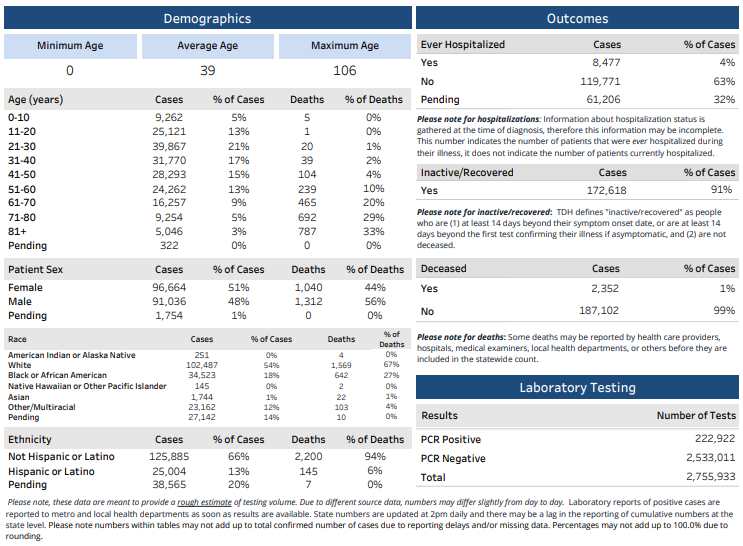
The disease appears to be especially deadly to older patients, according to data from the Tennessee Department of Health. As of Saturday, there had been at least 20 deaths among all age groups 21 years old and older, and 104 or more deaths starting with the 41-50 age group. The number of deaths continues to climb in older age groups. There have been between 239 and 787 deaths in the four oldest age groups: 51-60, 61-70, 71-80, and 81 and older.
The largest number of cases continues to be among patients who are 21 to 30 years old, followed by patients who are 31 to 40, and then patients who are 41 to 50.
While some people report no symptoms or mild symptoms, others become seriously ill from COVID-19, sometimes for weeks, and the effects can sometimes last for months. Others are admitted to the hospital, and some patients end up in intensive care and on ventilators.
To help prevent the virus from spreading, officials have repeatedly recommended that residents wear a face mask or covering when they are out of the house and around others, maintain a distance of at least six feet from other people when possible, and wash their hands frequently.
See the state’s data here and here.
See the CORE-19 website here.
See previous story here.
Leave a Reply